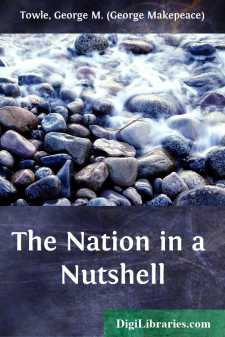Categories
- Antiques & Collectibles 13
- Architecture 36
- Art 48
- Bibles 22
- Biography & Autobiography 813
- Body, Mind & Spirit 142
- Business & Economics 28
- Children's Books 15
- Children's Fiction 12
- Computers 4
- Cooking 94
- Crafts & Hobbies 4
- Drama 346
- Education 46
- Family & Relationships 57
- Fiction 11828
- Games 19
- Gardening 17
- Health & Fitness 34
- History 1377
- House & Home 1
- Humor 147
- Juvenile Fiction 1873
- Juvenile Nonfiction 202
- Language Arts & Disciplines 88
- Law 16
- Literary Collections 686
- Literary Criticism 179
- Mathematics 13
- Medical 41
- Music 40
- Nature 179
- Non-Classifiable 1768
- Performing Arts 7
- Periodicals 1453
- Philosophy 64
- Photography 2
- Poetry 896
- Political Science 203
- Psychology 42
- Reference 154
- Religion 513
- Science 126
- Self-Help 84
- Social Science 81
- Sports & Recreation 34
- Study Aids 3
- Technology & Engineering 59
- Transportation 23
- Travel 463
- True Crime 29
The Nation in a Nutshell
Categories:
Description:
Excerpt
AMERICAN ANTIQUITIES.
[Sidenote: Geology and Archaeology.]
The sciences of geology and archaeology, working side by side, have made a wonderful progress in the past half a century. The one, seeking for the history and transformations of the physical earth, and the other, aiming to discover the antiquity, differences of race, and social and ethnical development of man, have obtained results which we cannot regard without amazement and more or less incredulity. The two sciences have been faithful handmaidens the one to the other; but geology has always led the way, and archaeology has been competed to follow in its path.
[Sidenote: Four Eras of Civilization.]
Though we may doubt as to the exactness of the detailed data established by the archaeologists, there are certain broad facts which we must accept from them as established beyond doubt. These facts are of the highest value and interest. The antiquary has been able, from discovered remains of extinct civilizations, to reconstruct societies and peoples, and to trace the occupancy of countries to periods far anterior to that of which history takes cognizance. The general fact seems to be settled that, in prehistoric times, Europe passed through four distinct eras. These were the Rude Stone Age, when man was the contemporary in Europe of the extinct hairy elephant and the cave bear; the Polished Stone Age; the Bronze Age, when bronze was used for arms and utensils; and the Iron Age, in which iron superseded bronze in the making of useful articles.
[Sidenote: Ancient America.]
In the same way it has been established that, on our own continent, the oldest discoverable civilization was one in which rude stone implements were used, and man lived contemporaneously with the megatherium and the mastodon. Then polished and worked stone implements came into use; and after the lapse of ages, copper. The researches of our antiquaries have rendered it probable that America is as ancient, as an inhabited continent, as Europe. Evidences have been brought to light, leading to the conclusion that many thousands of years before the Christian era, America was the seat of a civilization far from rude or savage. Groping into the remains of the far past, we find skeletons, skulls, implements of war, and even basket-work, buried in geological strata, which have been overlaid by repeated convulsions and changes of the physical earth. But so few are the relics of this dim, primeval period, that we can only conclude its antiquity, and we can infer little or nothing of its characteristics.
[Sidenote: Primeval Races.]
Advancing, however, another stage in research and discovery, we come upon clear and overwhelming proofs of the existence on this continent of a great, enterprising, skilful, and even artistic people, spread over an immense area, and leaving behind them the most positive testimony, not only of their existence, but of their manners and customs, their arts, their trade, their methods of warfare, and their religion and worship. Compared with this people, the Red Indians found here by the Pilgrims and the Cavaliers were modern intruders upon the land....


